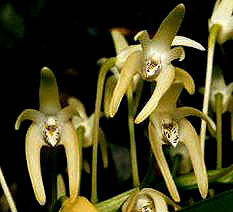Dendrobium tarberi
(King Orchid)
As the name suggests, this is the king of Australian epiphytic orchids (though in Sydney they refer to it as a "Rock Orchid"). It grows into large clumps, sometimes entirely encircling the trunk of its host tree (they are thus considerable size plants). The canes can be up to a meter long, and the flower spikes (racemes) as long as your fore-arm bearing scores of small white or creamy-yellow flowers, each about 30mm across. The plant does also occur on cliffs and on the ground and is said to grow into clumps up to 3 metres across, but collecting has probably decimated these plants (as it has many other orchids). I haven't come across any that size ... maybe one day! I have seen them growing as epiphytes on grass-trees which surprised me and was quite beautiful in flower.



Locally they tend to colonise brush box trees in the wet sclerophyll forest, and strangler figs and other large trees in the rainforest. Wandering in the bush, one occasionally catches sight of huge plants high in the canopy. When in full flower, the plant is an incredible sight with yellow blossoms cascading out from the plant.
Not long after seeting fruit, they ripen, split open and disperse thousands of tiny seeds.
There are a number of King Orchid species and subspecies, but in our area the plant commonly referred to as "King Orchid" is D. tarberi (formerly D. speciosum var. tarberi). So-named, according to D. Jones, because the local (Brisbane) aborigines called it Tar-beri. It is now referred to simply as Dendrobium tarberi, having recently achieved independent species status. Its typical form has numerous upright roots reaching 30+ cms up through the plant mass, which effectively act as a litter trap.

